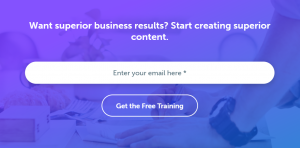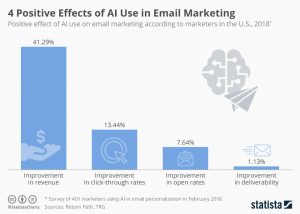Artificial intelligence (AI) has been changing the world over the last few years. Across a whole host of industries, this fascinating and emerging technology has fundamentally changed the way some of us work, providing a new set of tools for many professionals. In the world of marketing, AI and automation have been game-changers. Labor-intensive tasks can now be automated, and we have access to more insights and information than ever before. Given that it’s still a relatively new technology, many marketers are still playing catch-up. With that in mind, we’ve created this ultimate guide to using AI in email marketing campaigns.
As well as looking at email marketing strategies in general, we’ll also explore exactly what AI is and how it can help your marketing efforts. We’ll also look at some tools and examples to help you get started with your own AI email marketing efforts.
The most common challenges for a successful email marketing strategy
Before we get into how AI can enhance your email marketing strategy, let’s first explore some of the challenges that professionals face in this area. As we’ll see, many of these can be overcome by using artificial intelligence tools.
Integration
In the modern world, data is the new commodity. By gathering and utilizing huge sets of data, we can better understand the trends and information behind it. For marketing, this can mean the difference between success and failure. However, with a wide range of data streams, it can be hard to integrate the information to collate it in one place. Manually doing so is time-consuming and often frustrating.
Deliverability
The term deliverability refers to the rate of emails that are sent compared to those that make it to the intended recipients. Not every email you send will make it to its final destination, and this ‘bounce’ can be the result of a temporary or a permanent error. If you have a low deliverability rate, some ISPs may block you, which makes the situation much worse.
Growing and keeping subscribers
Any email marketer knows the struggle with trying to grow and maintain your mailing list. Obviously, you don’t want inactive and undeliverable contacts on your list. However, activities like buying email lists are no substitute. Growing your subscriber base is about finding high-quality leads that are likely to engage with your content.
Measuring effectiveness
How do you know if your email campaigns are a success? The answer may seem obvious, such as more sales or orders, but the results aren’t always that easy to measure. There are lots of factors that impact the sales process, and you need some fairly detailed analytics to appreciate the full spectrum.
Personalization
Building relationships with customers is about creating authentic connections. When you’re sending out generic emails to thousands of users, it can be hard to do so. Personalization plays a big role in increasing open rates and forging those relationships. However, without the right tools, it can be an almost impossible task to achieve with your email marketing.
Improving key metrics
This point relates back to measuring effectiveness. It’s one thing to understand what your bounce rate, open rate, and click-through and conversion rates are, but it’s another thing trying to increase them.
Questions to ask to optimize your email marketing strategy

So, now that we’ve identified some of the challenges that you might face with your email marketing, it’s time to look at some solutions. There are few cookie-cutter approaches here, as it often depends on your current activity and expectations. However, by asking several questions about your approach, you can start to optimize your email marketing strategy.
How do we manage our campaigns?
Think about the overall process of planning, executing, and analyzing your campaigns. Are the pre-defined roles and responsibilities? What software do you use and how does it integrate with your other systems? Who is accountable for the different elements? All of these questions should have a clear answer, and if not, you can start to clarify the process.
What does success look like?
What metrics determine whether or not an email is successful? Are you focused on open rates or conversions? Is the aim to drive sales or to increase traffic to your website? How do you measure performance year on year? Again, these points will differ depending on your circumstances, but you need firm answers if you’re to succeed.
Are we optimized for mobile?
It’s no secret that mobile users are accounting for increasing amounts of web traffic. What percentage of your users use mobile devices to read your emails? Is your content designed with these users in mind? Have you considered scalable and responsive design? How do mobile users react compared to desktop?
Who is our target audience?
Do you have a target audience in mind? What are the customer personas that you’re appealing to? How are you segmenting your approach to target different audiences? What data are you using to inform these choices? Each of these questions raises an important point about your targeted activity.
Are we testing new approaches?
What is your strategy for split testing? Which elements of the email are you going to differentiate? How regularly are you going to assess and test the success of your sends? Answering these questions can help you plan for future activity.
What is artificial intelligence (AI)?

The term artificial intelligence is one that comes straight out of a sci-fi movie. It conjures up images of robots mimicking human behavior and far-distant supercomputers. In reality, it’s a much more practical and contemporary thing.
AI is a term that actually covers a variety of different technologies. Machine learning, natural language processing, and deep learning all fall under this umbrella. However, it essentially refers to any computer-powered system that performs a cognitive task as well as or better than humans. Whether it’s a self-driving car, a streaming service’s recommendation engine, or a voice assistant, all of these are examples of artificial intelligence.
From a marketing perspective, we think of AI as an intelligent automation tool. As well as analyzing and processing large sets of data, marketing AI can make recommendations, predictions, and even its own decisions. It also takes out much of the manual work of sorting through data and populating fields.
How can email marketing benefit from AI?
Before we get into the specifics of how you can use AI in your email marketing, let’s first take a look at some of the general benefits it can bring. There are several ways in which AI can make your email marketing easier:
It saves you time
One of the key features of AI is the ability to automate tasks. Not only this, but a lot of technologies also adapt as they learn. So, previously time-consuming tasks can be done in the background, and often get more efficient and effective as time goes by.
It can improve results
With the adaptability of AI technology, you can soon start seeing results. As you refine your strategy, you’ll see key metrics such as open rates and click-through rates increase. You can also highlight the results you want to target and work to improve them.
It can increase revenue
With the improved results, you can also ensure that your email campaigns increase revenue. Similarly, the time you save with automation can be spent maximizing your revenue streams from other activities.
It can decrease costs
AI makes things faster and more efficient. As such, the costs associated with creating, executing, and analyzing your marketing campaigns will often decrease.
It can help refine your strategy
As you gather data and information about your email campaigns, you can soon start spotting patterns about your content and customers. With this insight, you can start making informed adjustments to your strategy to make it as effective as possible.
Different ways to use AI in your email marketing

So, how can you use AI to get your email marketing to another level? It’s a question with a wide variety of answers and strategies, showing just how powerful AI can be in the right circumstances. Yet it’s also a question of what you want to achieve from your activity.
Getting your email marketing to another level
The reason we outlined the challenges of email marketing and the questions you need to ask about your own is to give you some context for how you might use AI. Below, we’ve outlined several ways you can use the technology for your marketing activity:
Subject lines
A good subject line can be the difference between a successful email and one that fails to gain attention. Yet writing a captivating and enticing email subject line can be difficult and time-consuming. With an AI assistant, you can rely on natural language generation (NLG) to craft engaging subject lines that people are going to open.
There are a few caveats to this technology. It needs large sets of structured data to get started, for example. However, with the data in place, it can craft a wide range of narratives for all kinds of purposes and audiences. What’s more, it can do so in a fast and accurate manner.
Personalization
A successful email often goes beyond just an engaging headline. The content within is equally important, which is why personalized copy often goes across so well. With AI-powered tools, you can make sure each recipient receives content that’s going to appeal to their particular interests.
Again, this relies on having a strong and structured data set with plenty of information about each customer. However, with that in place, the possibilities are nearly endless. Couple that with the ability to produce natural-sounding text and you’re on to a winner.
Targeted email marketing
Targeting and segmentation are two of the most essential factors of a successful email campaign. So much so that the data suggests effective segmented email campaigns can increase revenue by up to 760%.
Targeted email marketing gives you the chance to send hyper-targeted content to a wide range of different users. When people opt in to your marketing emails, you have the chance to collect hundreds of different data points. With this data in place, you can start creating emails that are going to appeal to segments.
AI can help identify and target these segments. In doing so, you can create relevant emails that are going to get a high response rate. In turn, this creates more revue, builds a relationship with your customers, and makes sure you retain them.
There are a whole host of different ways you can split out your target email activity, including based on:
- Customer Type
- Interests
- Location
- Engagement
What’s more, with the help of AI, you can assess how well your activity is performing, giving you the chance to refine and retarget.
Deliverability
There are so many ways that you can increase your chances of a successful delivery, and AI can assist with many of these. For example, you can optimize send times to make sure that recipients receive your emails at a time when they’re likely to open them. Similarly, you can use historical data to restructure your campaigns to maximize delivery.
AI can also help identify where your mailing list is letting you down. Whether it’s by removing contacts that are no longer active or updating the details of those who are, this data management can help make sure that your emails are hitting the mark.
Ideas for developing effective email sign up

All of the details we’ve covered so far can be incredibly useful if you already have an established user base. However, what about if you don’t? If your email list is currently on the short side, you’ll need to spend some time and effort on growing it. To give you some guidance, we’ve outlined some quick tips for developing effective email sign up:
- Offer something. Whether it’s a free course, a discount code, or an e-book download, incentivize users to sign up to your mailing list with an offer of some sort.
- Keep it minimal. You don’t want to bombard your potential customers with a complex signup form. Instead, stick to a minimalistic approach, keeping your colors, fonts, and information straightforward.
- Give it prominence. Without making it too intrusive, give your email signup the real estate it needs on your website. Try and find places where the eye naturally falls and include a call to action for it.
- Choose a CTA that works. Speaking of calls to action, try and make yours more engaging than simply ‘sign up here’. Try and put a unique spin that incites movement and encourages engagement.
- Test and test again. It’s highly unlikely that you’re going to get the right format straight away. Spend some time A/B and split testing your ideas to see which ones resonate with visitors.
How can AI email campaigns increase sales?
When it comes to seeing the results of AI in email campaigns, the results speak for themselves. According to a report from Statista, around 41% of marketers said that artificial intelligence helped improve their company’s revenue in their email marketing. But how does it do so?

Much of this improvement is seen from the insights that AI can provide. When it comes to gathering, processing, organizing, and presenting data, AI takes things to the next level. In turn, this means that marketers have more access to information than ever before. You can gain an understanding of your subscribers and customers in greater detail, meaning it’s easier to give them what they want.
What this all means is that, as a marketer, you can tailor your approach to a more granular level. As a result, you can expect:
- More engaged subscribers. When subject lines and content are personalized, it’s more likely a recipient is going to interact with the email.
- Personalized offers. We already know how effective segmented email campaigns can be, and providing highly personalized offers only contributes to this. As such, your ROI greatly increases.
- Remarketing. By using AI tools, you can ensure that hot leads (such as customers adding items to their basket) are encouraged to convert. AI can spot patterns and details to make sure the email reaches them at a time and in a way that makes them more likely to purchase.
How to write better emails using AI
All of this talk of artificial intelligence may make you think that all of the hands-on tasks of email marketing can be automated. Thankfully (or sadly), that’s not the case. While AI can automate some tasks, with others, it can only assist. The content side of things is particularly hard to automate. After all, our language relies on creativity and nuance to be successful.
When it comes to writing better emails using AI, you’ll need to use a data-driven approach. For example, you might split test a subject line and find that one particular version works better. It’s not always easy to know why this is, but with an AI tool, you can get greater insight. From here, you can use AI to quantify, generate, and optimize subject lines. The more results you get, the greater level of tailored results you’ll get.
Other tools examine the body content of your email to see how likely it is to evoke a response. The complex algorithms analyze what you’re writing and suggest ways to improve them. Similar to the subject line AI, it also examines the data from emails you’ve sent to make recommendations.
Examples of AI in email marketing
We’ve already covered a wide range of examples of how AI can assist in email marketing. However, there are a few others too. To give a clearer picture, we’ve rounded up some of the main examples of how the technology is used:
- Subject lines. Optimize what your customers see to encourage them to open your emails. The more data you have, the more accurately AI tools can assist.
- Body content. Create content that matches the tone of voice and style that your customers are going to respond to.
- Personalization. Segment your emails on a granular level, making sure that customers only receive content that is highly relevant to them.

- Timings. Analyze email send times to find the optimum window for each customer. Automatically send emails during these times.
- Retargeting. Make sure a customer that has engaged with your brand doesn’t fall by the wayside. AI retargeting can identify different types of customers and send retargeting at the right time.
AI tools to help you in your outreach efforts
So, which tools can help you with your email outreach efforts? There are several out there, often designed with one particular element in mind. Here are some of the ones to consider:
Bant
With our email outreach tools, you can make sure your sales outreach is as effective as possible. You’ll gain access to lead generation strategies that are made with you in mind. The AI-powered engine ensures that each of your campaigns is tailored for success, constantly improving conversion and lead quality.
What’s more, you’ll also gain access to highly customized experiment suggestions. These can be applied to your campaigns with the click of a button, giving you the chance to improve on the effectiveness of your campaign based on real-time data.
Phrasee
For subject lines, Phrasee can be a useful tool. It generates and optimizes these titles, based on your company’s tone of voice and style.
Seventh Sense
If you’re looking for a tool that’s focused on delivery times for your email, Seventh Sense can be useful. It gathers data on how prospects and customers interact with your content to optimize when your emails are sent.
The future of AI and email marketing

A lot of the topics we’ve covered in this article already seem pretty futuristic. However, the exciting thing is that it’s all available now. What’s more, this is a relatively new technology, meaning there’s plenty of scope for growth and improvement ahead. So what does the future hold?
While it’s impossible to say exactly, there are some trends that we can likely identify. For one, the reliance on data will continue. And, as we’re all creating vast amounts of data each day, this approach will only become more refined.
It’s unlikely that AI will totally take over the role of human email marketers. As we’ve already mentioned, this type of marketing requires creativity and a human touch. However, AI will continue to assist and augment our efforts, making the process more refined. This will benefit customers and email marketers.

